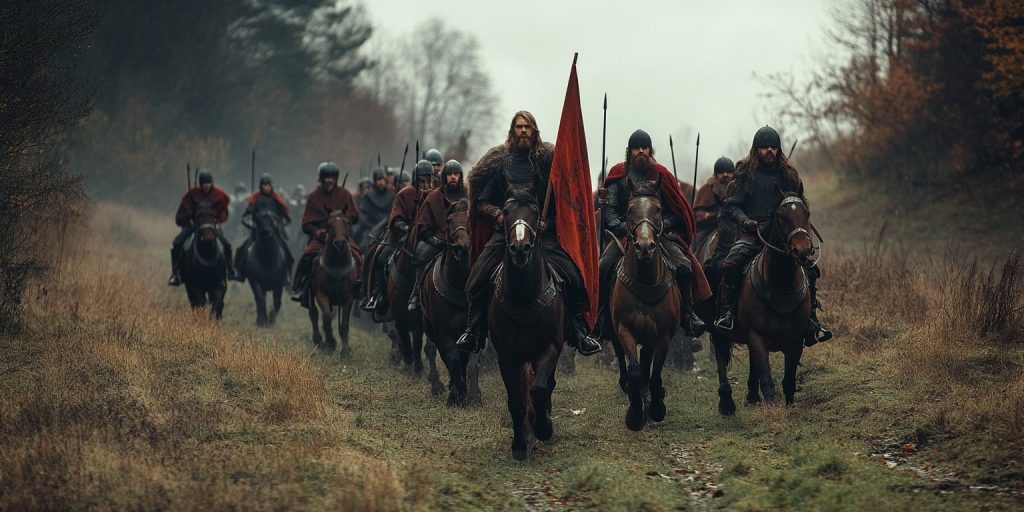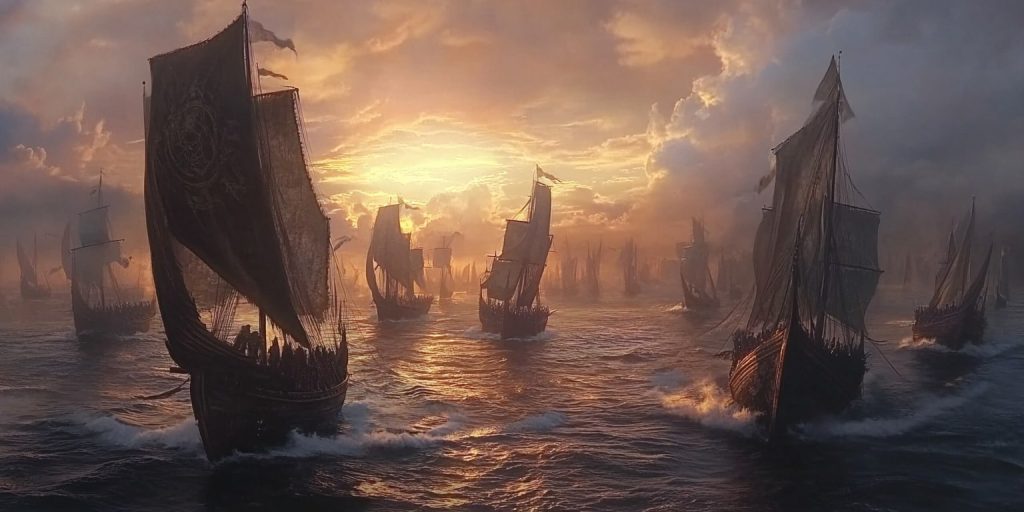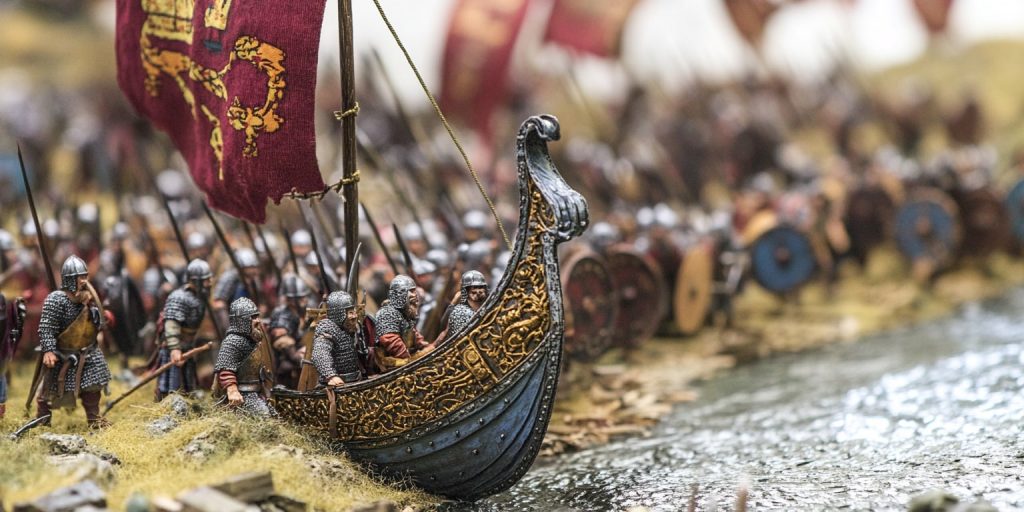Viking Politics, Viking Raids and Warfare, Vikings
Did Vikings Ever Fight On Horseback?
The Vikings were known for their sailing skills and battle tactics, and they have always fascinated us. But did they fight on horseback? The answer is not as simple as we might think.
Historical records show Vikings used horses, but not as much as we imagine. It’s not like they had cavalry charging into battles. Let’s explore the Viking battlefield and their use of horses in society.
We’ll investigate their military strategies and horse use to determine whether Vikings fought on horseback. Stay with us to uncover the truth.
Introduction to Viking Warfare
Viking warfare was vital in the Viking Age, which lasted for centuries and included impressive raids across Europe. Viking warriors were known for their fierce battle skills.
They used advanced tactics to win. Their famous longships helped them move fast over seas and rivers. These ships made their raids and invasions quick and surprising.
Surprise attacks were a big part of Viking warfare. They liked quick battles that shocked their enemies. Raiding villages were common, leading to looting and fear among locals.
Culture played a big role in their battles. The Vikings valued honor and bravery. Knowing this helps us understand their military tactics better.
Understanding Viking Culture and Military Tactics
Viking culture was deeply connected to Norse traditions, which shaped their way of war and military. They believed in the value of battle, which drove warriors to seek glory and a place in Valhalla.
This belief made them very committed to being great in combat and finding smart ways to fight.
Viking tactics were all about being fast and surprising. Warriors would often attack quickly before the enemy could react. They used:
- Ambushes that used the land and weather to their advantage.
- Hit-and-run tactics, striking fast and retreating before the enemy could get back together.
- Coordinated attacks, combining land and sea forces to overwhelm their foes.
We learn about their military tools and strategies from Viking times, burial sites, and sagas. Their armor and weapons were not just helpful but also beautiful. This showed their pride in Norse culture, often celebrated in tales of the great heathen army.
They fought in groups, like the shield wall, showing how important teamwork was to them. This teamwork helped them win battles, showcasing the effectiveness of their battle strategies.
Role of Horses in Viking Society
Horses were more than just a way for Vikings to get around. They played key roles in their daily lives and military plans. Knowing how horses helped Vikings shows their deep connection to travel, raids, and homes.
Importance of Horses for Transportation
Horses were crucial for moving around Scandinavia’s vast and rough lands, allowing the Norsemen to execute their battle strategies effectively. They let leaders and fighters travel long distances. Horses helped with many tasks, like:
- Carrying goods and people between Viking homes was essential for sustaining their kingdom.
- Helping with farm work like plowing and hauling
- Linking trade paths across the area
This helped Vikings move goods and people, boosting trade and community ties.
Horses in Viking Raids and Settlements
In Viking raids, horses were key but often forgotten. While most fighters walked, horses sometimes helped win battles. They were used for:
- Quick spy missions behind enemy lines
- Fast attacks on weak spots
- Helping set up and protect new Viking homes
Horses showed their value in raids and settling new lands. They helped Vikings adjust to new places, making it easier for them to succeed. Seeing how horses helped Vikings shows their big role in raids and building new homes, similar to the strategies used by Byrhtnoth.
The Viking Battlefield
The terrain and battle conditions shaped the Viking battlefield. Vikings fought in many places, from coastlines to dense forests. Each place needed special battle plans to use its strengths and avoid weaknesses.
Terrain and Conditions of Viking Battles
The battlefield’s geography was key to viking battles’ outcomes. Important factors were:
- The open field was great for big battles and shield walls.
- Coastal areas were good for naval attacks and ambushes.
- Wooded areas were perfect for surprise attacks.
Infantry vs. Cavalry: Viking Strategies
Vikings mostly used infantry with shields, spears, and axes, essential in their battle strategies. Their tactics showed how good their infantry was compared to cavalry. Key points were:
- Shield walls were vital for defense and stable fronts.
- Formations helped in coordinated attacks, using infantry strengths.
- Though there were talks of cavalry, infantry was central to their battles.
The mix of infantry and cavalry shows how Vikings adapted to different battle conditions and excelled in many combat situations.
Evidence of Viking Cavalry

Did Vikings use horses? For years, historians and archaeologists have wondered about Viking cavalry. Some stories and old texts mention horseback fights but don’t show clear proof. We look at stories that suggest Vikings might have used cavalry in battles.
Historical Accounts of Horseback Combat
Old stories and sagas give us glimpses of Viking horseback fights. They show warriors fighting while on horseback. However, these stories are unclear, making us question their truth.
Debates Among Scholars
Experts still argue about Viking cavalry. Some say Vikings mostly fought on foot, while others believe cavalry was used in some battles. Different views on old texts fuel the debate and find.
Famous Viking Battles
The Viking Age saw many important battles that changed history. The Battle of Stamford Bridge and the Battle of Clontarf are key examples. They show the tactics and results of Viking warfare.
Battle of Stamford Bridge
In 1066, the Battle of Stamford Bridge was a big fight, marking a significant moment in the clash between Norsemen and Anglo-Saxon forces. It was between King Harald Hardrada’s army and the English. This battle showed the Vikings’ power was fading in England.
Hardrada used old Viking tactics, like quick attacks, but the Vikings lost. This loss changed who was in charge in England.
Battle of Clontarf
The Battle of Clontarf happened in 1014. It was a big fight in Ireland between Vikings and Irish troops led by Brian Boru. This battle ended Viking raids and settlements in Ireland.
Boru’s troops used smart infantry plans, and the Vikings fought with their usual bold style. After the battle, Ireland’s politics changed, and Viking power declined.
Strategies Used in Key Battles
Viking strategies were varied and changed with each battle. Important parts included:
- Using the land to their advantage.
- Formations that made their warriors strong.
- Surprise attacks to mess up the enemy.
These plans were key in Viking battles. They helped Vikings fight off many enemies.
Differences Between Vikings and Anglo-Saxons
The Vikings and Anglo-Saxons had different ways of fighting and organizing their armies. Their methods were shaped by their values and where they lived.
Combat Techniques
Vikings were fast and sneaky, catching their foes off guard. They used quick attacks and then quickly left. This was because they had light, fast troops.
On the other hand, the Anglo-Saxons fought from strong positions. They used heavy infantry and shield walls to defend, which showed their defensive strategy.
Knowing these differences helps us understand how each group fought. It shows how they faced their enemies.
Military Leadership and Organization
Viking leaders were chieftains who led by example, leading to a less formal command structure. In contrast, Anglo-Saxons had kings and ealdorman leading them. This made their military more organized and structured, resembling the disciplined forces of Wessex.
This difference in leadership affected their decisions and battle plans, making their armies solid and effective.
Alternatives to Horseback Fighting
The Vikings were very good at changing their military plans. They didn’t focus much on horseback fighting. But they were great at using ships and fighting on foot. They used viking ships and longships and fought in shield walls and with infantry tactics.
Use of Ships and Longships in Warfare
Viking ships, especially longships, were key to their success. They could quickly attack coastlines and raid inland, a hallmark of their Viking fleets. Longships were made to move fast on rivers and estuaries.

- Fast transportation of troops during naval battles
- Surprise attacks on unprotected coastlines
- Efficient retreats under challenging circumstances
Being good at the sea helped the Vikings control important waterways, enabling their Viking fleets to launch surprise attacks. This was crucial for their military plans. Their skill with longships showed their clever tactics and planning.
Shield Walls and Infantry Tactics
Shield walls were a big part of Viking fighting. Warriors stood together, shields up, to protect each other and make themselves strong in battles.
- Enhanced protection against projectiles
- Improved organization in chaotic battle situations
- Effective communication and support among infantry
Vikings also used different fighting styles. They moved around the enemy and attacked together. This teamwork and smart planning helped them win many battles.
Viking Leaders and Their Armies
Viking warfare was shaped by strong leaders who brought warriors together. These leaders, like famous kings and chieftains, were skilled in war and strategy. Their leadership helped Viking forces succeed in battles, contributing to the legacy of the greatest Viking battles.
Famous Viking Kings and Chieftains
Leaders like Ragnar Lothbrok and Cnut the Great were key to Viking success. They inspired their warriors to conquer new lands, much like the legendary figures in the Battle of Maldon. Ragnar’s raids in France and England made Vikings famous. Cnut united England and Denmark, showing the power of good leadership.
How Viking Armies Were Structured
Viking armies were organized in a clear hierarchy. This helped them fight well and stay efficient. The army had:
- Warriors: The main fighters, armed with axes, swords, and shields.
- Commanders: Led units and made plans for battles.
- Support Personnel: Took care of food, supplies, and medical needs.
This structure helped Viking leaders use their armies well. They could face different challenges and work together on various terrains.
Conclusion
Viking warfare was a mix of military strategy and cultural practices. They mostly used infantry, but the role of horses is still debated. The Vikings were known for their ground tactics but also adaptable.
Their use of terrain and naval power was key to their success. They used infantry formations and ships to innovate. This adaptability made them successful in many battles.
Viking warfare is still fascinating today. It shows how their military strategies were part of their everyday life. Learning about their history teaches us about their values and lifestyles.

